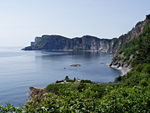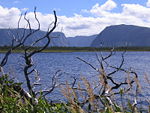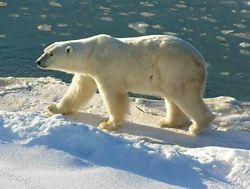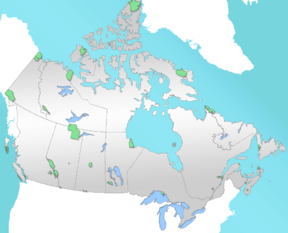As of 2008, there are 36 National Parks and six National Park Reserves. Not included among the total is Kluane National Park and Reserve, which is considered both a National Park and a Reserve. This list also includes the country's two National Marine Conservation Areas (NMCAs), the lone National Landmark, and three future parks.
A National Park Reserve is an area that has been set aside with the intention of becoming a national park, pending the settlement of native land claims. Until then, they are managed as national parks under the National Parks Act.[3]
| Name |
Location |
Area |
Established |
| Aulavik National Park |
Northwest Territories |
&0000000000012200.00000012,200 12,200 km2 (4,710 sq mi) |
1992 |
| Auyuittuq National Park |
Nunavut |
&0000000000021471.00000021,471 21,471 km2 (8,290 sq mi) |
2001 |
| Banff National Park |
Alberta |
&0000000000006641.0000006,641 6,641 km2 (2,564 sq mi) |
1885 |
| Bruce Peninsula National Park |
Ontario |
&0000000000000154.000000154 154 km2 (59 sq mi) |
1987 |
| Cape Breton Highlands National Park |
Nova Scotia |
&0000000000000949.000000949 949 km2 (366 sq mi) |
1936 |
| Elk Island National Park |
Alberta |
&0000000000000194.000000194 194 km2 (75 sq mi) |
1913 |
| Forillon National Park |
Quebec |
&0000000000000244.000000244 244 km2 (94 sq mi) |
1970 |
| Fundy National Park |
New Brunswick |
&0000000000000206.000000206 206 km2 (80 sq mi) |
1948 |
| Georgian Bay Islands National Park |
Ontario |
&0000000000000013.00000013 13 km2 (5 sq mi) |
1929 |
| Glacier National Park |
British Columbia |
&0000000000001349.0000001,349 1,349 km2 (521 sq mi) |
1886 |
| Grasslands National Park |
Saskatchewan |
&0000000000000907.000000907 907 km2 (350 sq mi) |
1981 |
| Gros Morne National Park |
Newfoundland |
&0000000000001805.0000001,805 1,805 km2 (697 sq mi) |
1973 |
| Gulf Islands National Park Reserve |
British Columbia |
&0000000000000033.00000033 33 km2 (13 sq mi) |
2003 |
| Gwaii Haanas National Park Reserve and Haida Heritage Site[4] |
British Columbia |
&0000000000001495.0000001,495 1,495 km2 (577 sq mi) |
1988 |
| Ivvavik National Park[5] |
Yukon |
&0000000000010168.00000010,168 10,168 km2 (3,926 sq mi) |
1984 |
| Jasper National Park |
Alberta |
&0000000000010878.00000010,878 10,878 km2 (4,200 sq mi) |
1907 |
| Kejimkujik National Park |
Nova Scotia |
&0000000000000404.000000404 404 km2 (156 sq mi) |
1968 |
| Kluane National Park and Reserve[6] |
Yukon |
&0000000000022013.00000022,013 22,013 km2 (8,499 sq mi) |
1972 |
| Kootenay National Park |
British Columbia |
&0000000000001406.0000001,406 1,406 km2 (543 sq mi) |
1920 |
| Kouchibouguac National Park |
New Brunswick |
&0000000000000239.000000239 239 km2 (92 sq mi) |
1969 |
| La Mauricie National Park |
Quebec |
&0000000000000536.000000536 536 km2 (207 sq mi) |
1970 |
| Mingan Archipelago National Park Reserve |
Quebec |
&0000000000000151.000000151 151 km2 (58 sq mi) |
1984 |
| Mount Revelstoke National Park |
British Columbia |
&0000000000000260.000000260 260 km2 (100 sq mi) |
1914 |
| Nahanni National Park Reserve |
Northwest Territories |
&0000000000004766.0000004,766 4,766 km2 (1,840 sq mi)[7] |
1976 |
| Pacific Rim National Park Reserve |
British Columbia |
&0000000000000511.000000511 511 km2 (197 sq mi) |
1970 |
| Point Pelee National Park |
Ontario |
&0000000000000015.00000015 15 km2 (6 sq mi) |
1918 |
| Prince Albert National Park |
Saskatchewan |
&0000000000003874.0000003,874 3,874 km2 (1,496 sq mi) |
1927 |
| Prince Edward Island National Park |
Prince Edward Island |
&0000000000000022.00000022 22 km2 (8 sq mi) |
1937 |
| Pukaskwa National Park |
Ontario |
&0000000000001878.0000001,878 1,878 km2 (725 sq mi) |
1978 |
| Quttinirpaaq National Park[8] |
Nunavut |
&0000000000037775.00000037,775 37,775 km2 (14,585 sq mi) |
2001 |
| Riding Mountain National Park[9] |
Manitoba |
&0000000000002973.0000002,973 2,973 km2 (1,148 sq mi) |
1929 |
| Sirmilik National Park |
Nunavut |
&0000000000022200.00000022,200 22,200 km2 (8,571 sq mi) |
2001 |
| St. Lawrence Islands National Park |
Ontario |
&0000000000000009.0000009 9 km2 (3 sq mi) |
1914 |
| Terra Nova National Park |
Newfoundland |
&0000000000000400.000000400 400 km2 (154 sq mi) |
1957 |
| Torngat Mountains National Park Reserve |
Labrador |
&0000000000009600.0000009,600 9,600 km2 (3,707 sq mi) |
2005 |
| Tuktut Nogait National Park |
Northwest Territories |
&0000000000016340.00000016,340 16,340 km2 (6,309 sq mi) |
1996 |
| Ukkusiksalik National Park |
Nunavut |
&0000000000020500.00000020,500 20,500 km2 (7,915 sq mi) |
2003 |
| Vuntut National Park |
Yukon |
&0000000000004345.0000004,345 4,345 km2 (1,678 sq mi) |
1995 |
| Wapusk National Park |
Manitoba |
&0000000000011475.00000011,475 11,475 km2 (4,431 sq mi) |
1996 |
| Waterton Lakes National Park[10] |
Alberta |
&0000000000000505.000000505 505 km2 (195 sq mi) |
1895 |
| Wood Buffalo National Park |
Alberta/Northwest Territories |
&0000000000044807.00000044,807 44,807 km2 (17,300 sq mi) |
1922 |
| Yoho National Park |
British Columbia |
&0000000000001313.0000001,313 1,313 km2 (507 sq mi) |
1886 |
National Marine Conservation Areas (NMCAs) are a relatively new addition to the park system. These areas have a different mandate than their terrestrial counterparts. They are designed for sustainable use, although they usually also contain areas designed to protect ecological integrity.[17]
The government has announced plans to add five more Marine parks to the system as part of the Marine Conservation Areas Act. The first to be officially announced was Lake Superior National Marine Conservation Area, although a date of opening has not yet been revealed. Other areas under negotiation are the southern Strait of Georgia and Gwaii Haanas in British Columbia and there are discussions to study the feasibility of an area on the southern coast of Newfoundland.[19]
In addition to national parks, a National Landmarks program was established in 1978 but has not yet been expanded beyond a single property. Landmarks were intended to protect specific natural features considered "outstanding, exceptional, unique, or rare to this country. These natural features would typically be isolated entities and of scientific interest."[21]
Provincial parks are administered and funded by the provincial governments, however some provincial parks are categorized as national parks (Category II) under the IUCN's Protected Area Management Categories.









